Detailed Financial Analysis of JP Morgan Chase: Basel III and Crisis
VerifiedAdded on 2020/04/15
|21
|6076
|61
Report
AI Summary
This report offers a detailed analysis of JP Morgan Chase, examining its key contributions to the US financial system. It delves into the problems associated with debt financing, particularly the challenges faced by financial surplus units. The report provides a comprehensive overview of the changes introduced by Basel III regarding capital adequacy, liquidity, and leverage requirements, and assesses their impact on JP Morgan Chase's financial condition. Furthermore, it explores the process of asset securitization and the bank's motivations for engaging in it. Finally, the report analyzes the implications of the 2008 financial crisis on JP Morgan Chase's financial performance, including the measures implemented by the US government to stabilize the markets. The analysis covers critical aspects such as maturity mismatch, size mismatch and high interest rates.
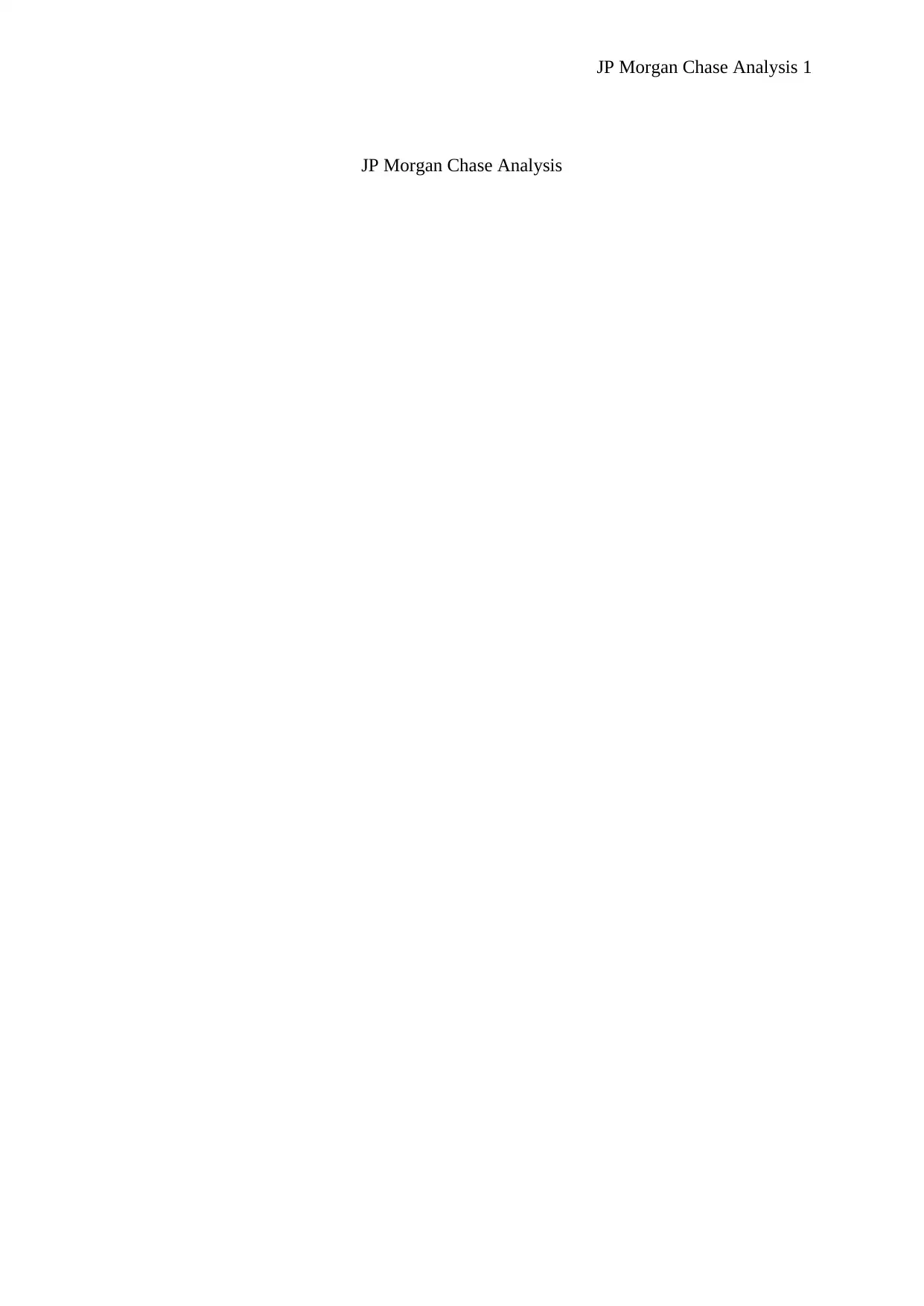
JP Morgan Chase Analysis 1
JP Morgan Chase Analysis
JP Morgan Chase Analysis
Paraphrase This Document
Need a fresh take? Get an instant paraphrase of this document with our AI Paraphraser
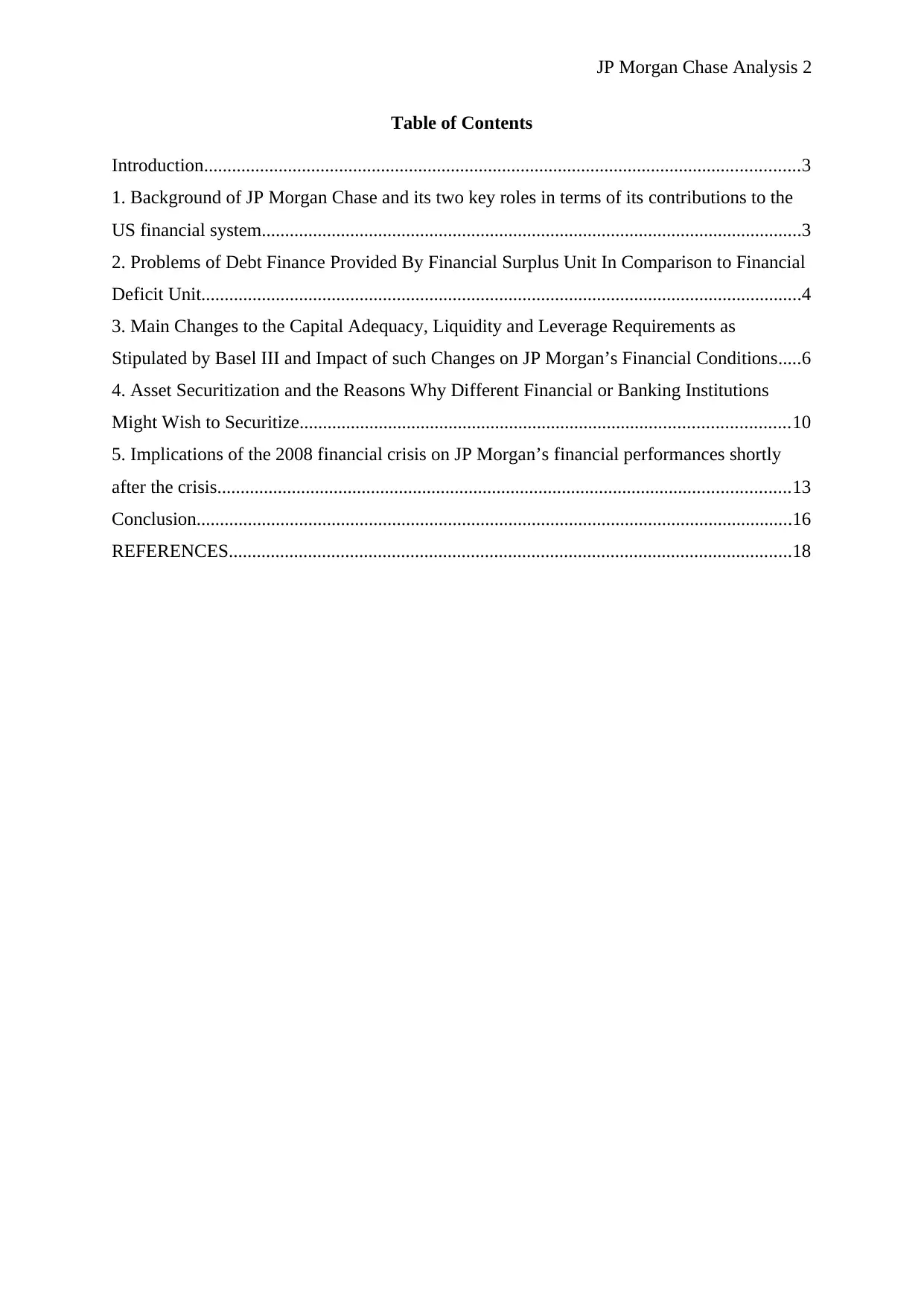
JP Morgan Chase Analysis 2
Table of Contents
Introduction................................................................................................................................3
1. Background of JP Morgan Chase and its two key roles in terms of its contributions to the
US financial system....................................................................................................................3
2. Problems of Debt Finance Provided By Financial Surplus Unit In Comparison to Financial
Deficit Unit.................................................................................................................................4
3. Main Changes to the Capital Adequacy, Liquidity and Leverage Requirements as
Stipulated by Basel III and Impact of such Changes on JP Morgan’s Financial Conditions.....6
4. Asset Securitization and the Reasons Why Different Financial or Banking Institutions
Might Wish to Securitize.........................................................................................................10
5. Implications of the 2008 financial crisis on JP Morgan’s financial performances shortly
after the crisis...........................................................................................................................13
Conclusion................................................................................................................................16
REFERENCES.........................................................................................................................18
Table of Contents
Introduction................................................................................................................................3
1. Background of JP Morgan Chase and its two key roles in terms of its contributions to the
US financial system....................................................................................................................3
2. Problems of Debt Finance Provided By Financial Surplus Unit In Comparison to Financial
Deficit Unit.................................................................................................................................4
3. Main Changes to the Capital Adequacy, Liquidity and Leverage Requirements as
Stipulated by Basel III and Impact of such Changes on JP Morgan’s Financial Conditions.....6
4. Asset Securitization and the Reasons Why Different Financial or Banking Institutions
Might Wish to Securitize.........................................................................................................10
5. Implications of the 2008 financial crisis on JP Morgan’s financial performances shortly
after the crisis...........................................................................................................................13
Conclusion................................................................................................................................16
REFERENCES.........................................................................................................................18
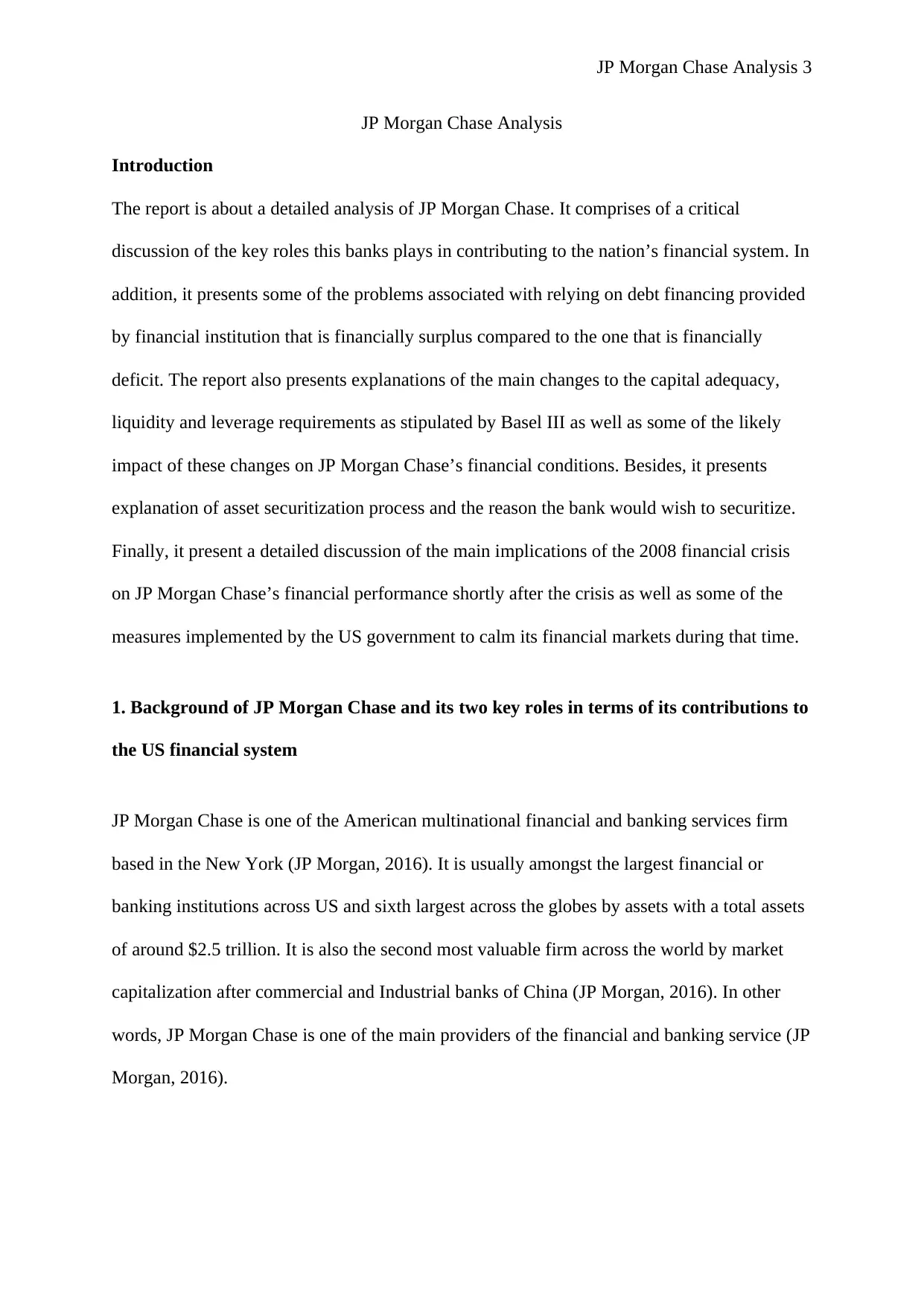
JP Morgan Chase Analysis 3
JP Morgan Chase Analysis
Introduction
The report is about a detailed analysis of JP Morgan Chase. It comprises of a critical
discussion of the key roles this banks plays in contributing to the nation’s financial system. In
addition, it presents some of the problems associated with relying on debt financing provided
by financial institution that is financially surplus compared to the one that is financially
deficit. The report also presents explanations of the main changes to the capital adequacy,
liquidity and leverage requirements as stipulated by Basel III as well as some of the likely
impact of these changes on JP Morgan Chase’s financial conditions. Besides, it presents
explanation of asset securitization process and the reason the bank would wish to securitize.
Finally, it present a detailed discussion of the main implications of the 2008 financial crisis
on JP Morgan Chase’s financial performance shortly after the crisis as well as some of the
measures implemented by the US government to calm its financial markets during that time.
1. Background of JP Morgan Chase and its two key roles in terms of its contributions to
the US financial system
JP Morgan Chase is one of the American multinational financial and banking services firm
based in the New York (JP Morgan, 2016). It is usually amongst the largest financial or
banking institutions across US and sixth largest across the globes by assets with a total assets
of around $2.5 trillion. It is also the second most valuable firm across the world by market
capitalization after commercial and Industrial banks of China (JP Morgan, 2016). In other
words, JP Morgan Chase is one of the main providers of the financial and banking service (JP
Morgan, 2016).
JP Morgan Chase Analysis
Introduction
The report is about a detailed analysis of JP Morgan Chase. It comprises of a critical
discussion of the key roles this banks plays in contributing to the nation’s financial system. In
addition, it presents some of the problems associated with relying on debt financing provided
by financial institution that is financially surplus compared to the one that is financially
deficit. The report also presents explanations of the main changes to the capital adequacy,
liquidity and leverage requirements as stipulated by Basel III as well as some of the likely
impact of these changes on JP Morgan Chase’s financial conditions. Besides, it presents
explanation of asset securitization process and the reason the bank would wish to securitize.
Finally, it present a detailed discussion of the main implications of the 2008 financial crisis
on JP Morgan Chase’s financial performance shortly after the crisis as well as some of the
measures implemented by the US government to calm its financial markets during that time.
1. Background of JP Morgan Chase and its two key roles in terms of its contributions to
the US financial system
JP Morgan Chase is one of the American multinational financial and banking services firm
based in the New York (JP Morgan, 2016). It is usually amongst the largest financial or
banking institutions across US and sixth largest across the globes by assets with a total assets
of around $2.5 trillion. It is also the second most valuable firm across the world by market
capitalization after commercial and Industrial banks of China (JP Morgan, 2016). In other
words, JP Morgan Chase is one of the main providers of the financial and banking service (JP
Morgan, 2016).
⊘ This is a preview!⊘
Do you want full access?
Subscribe today to unlock all pages.

Trusted by 1+ million students worldwide
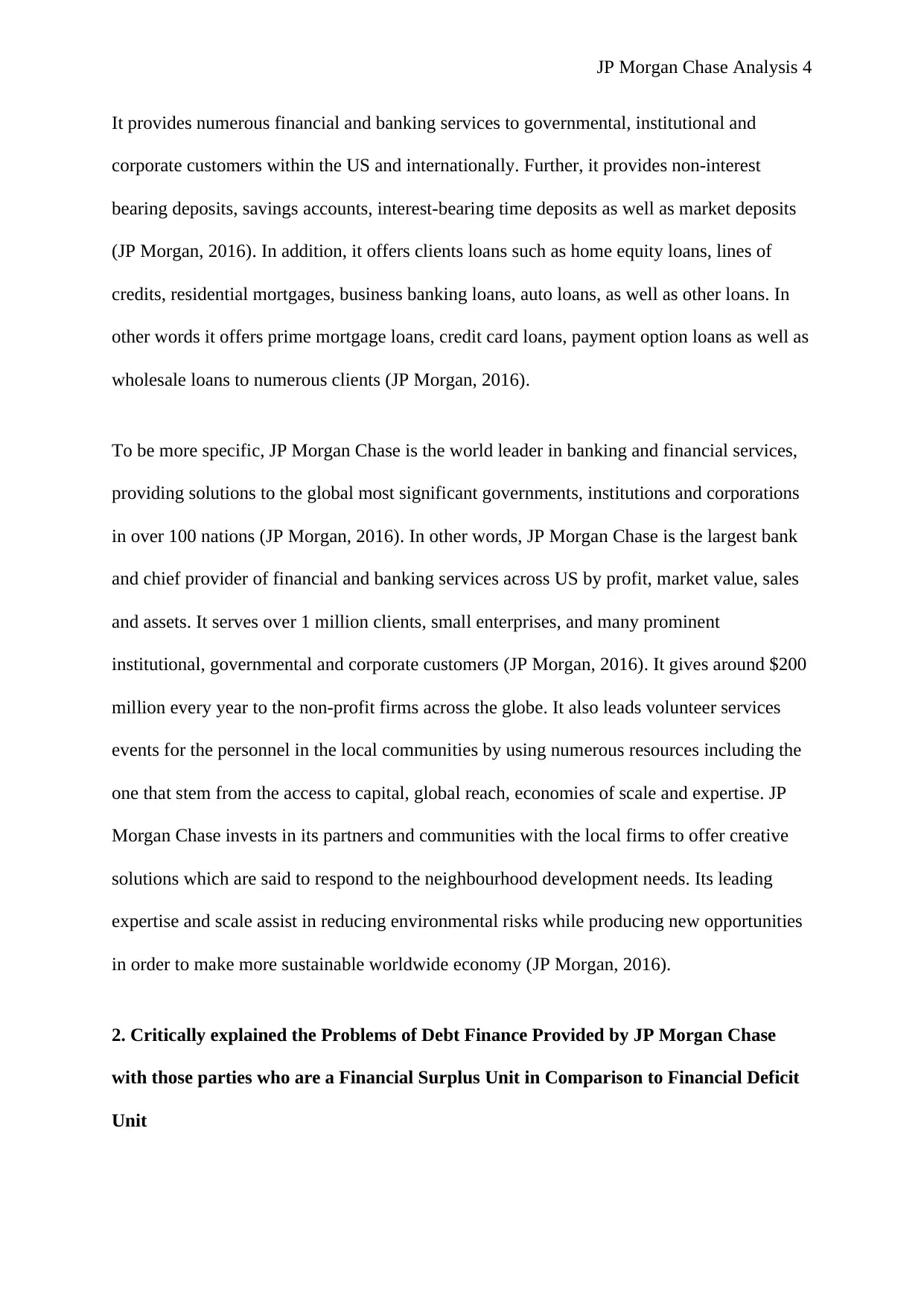
JP Morgan Chase Analysis 4
It provides numerous financial and banking services to governmental, institutional and
corporate customers within the US and internationally. Further, it provides non-interest
bearing deposits, savings accounts, interest-bearing time deposits as well as market deposits
(JP Morgan, 2016). In addition, it offers clients loans such as home equity loans, lines of
credits, residential mortgages, business banking loans, auto loans, as well as other loans. In
other words it offers prime mortgage loans, credit card loans, payment option loans as well as
wholesale loans to numerous clients (JP Morgan, 2016).
To be more specific, JP Morgan Chase is the world leader in banking and financial services,
providing solutions to the global most significant governments, institutions and corporations
in over 100 nations (JP Morgan, 2016). In other words, JP Morgan Chase is the largest bank
and chief provider of financial and banking services across US by profit, market value, sales
and assets. It serves over 1 million clients, small enterprises, and many prominent
institutional, governmental and corporate customers (JP Morgan, 2016). It gives around $200
million every year to the non-profit firms across the globe. It also leads volunteer services
events for the personnel in the local communities by using numerous resources including the
one that stem from the access to capital, global reach, economies of scale and expertise. JP
Morgan Chase invests in its partners and communities with the local firms to offer creative
solutions which are said to respond to the neighbourhood development needs. Its leading
expertise and scale assist in reducing environmental risks while producing new opportunities
in order to make more sustainable worldwide economy (JP Morgan, 2016).
2. Critically explained the Problems of Debt Finance Provided by JP Morgan Chase
with those parties who are a Financial Surplus Unit in Comparison to Financial Deficit
Unit
It provides numerous financial and banking services to governmental, institutional and
corporate customers within the US and internationally. Further, it provides non-interest
bearing deposits, savings accounts, interest-bearing time deposits as well as market deposits
(JP Morgan, 2016). In addition, it offers clients loans such as home equity loans, lines of
credits, residential mortgages, business banking loans, auto loans, as well as other loans. In
other words it offers prime mortgage loans, credit card loans, payment option loans as well as
wholesale loans to numerous clients (JP Morgan, 2016).
To be more specific, JP Morgan Chase is the world leader in banking and financial services,
providing solutions to the global most significant governments, institutions and corporations
in over 100 nations (JP Morgan, 2016). In other words, JP Morgan Chase is the largest bank
and chief provider of financial and banking services across US by profit, market value, sales
and assets. It serves over 1 million clients, small enterprises, and many prominent
institutional, governmental and corporate customers (JP Morgan, 2016). It gives around $200
million every year to the non-profit firms across the globe. It also leads volunteer services
events for the personnel in the local communities by using numerous resources including the
one that stem from the access to capital, global reach, economies of scale and expertise. JP
Morgan Chase invests in its partners and communities with the local firms to offer creative
solutions which are said to respond to the neighbourhood development needs. Its leading
expertise and scale assist in reducing environmental risks while producing new opportunities
in order to make more sustainable worldwide economy (JP Morgan, 2016).
2. Critically explained the Problems of Debt Finance Provided by JP Morgan Chase
with those parties who are a Financial Surplus Unit in Comparison to Financial Deficit
Unit
Paraphrase This Document
Need a fresh take? Get an instant paraphrase of this document with our AI Paraphraser
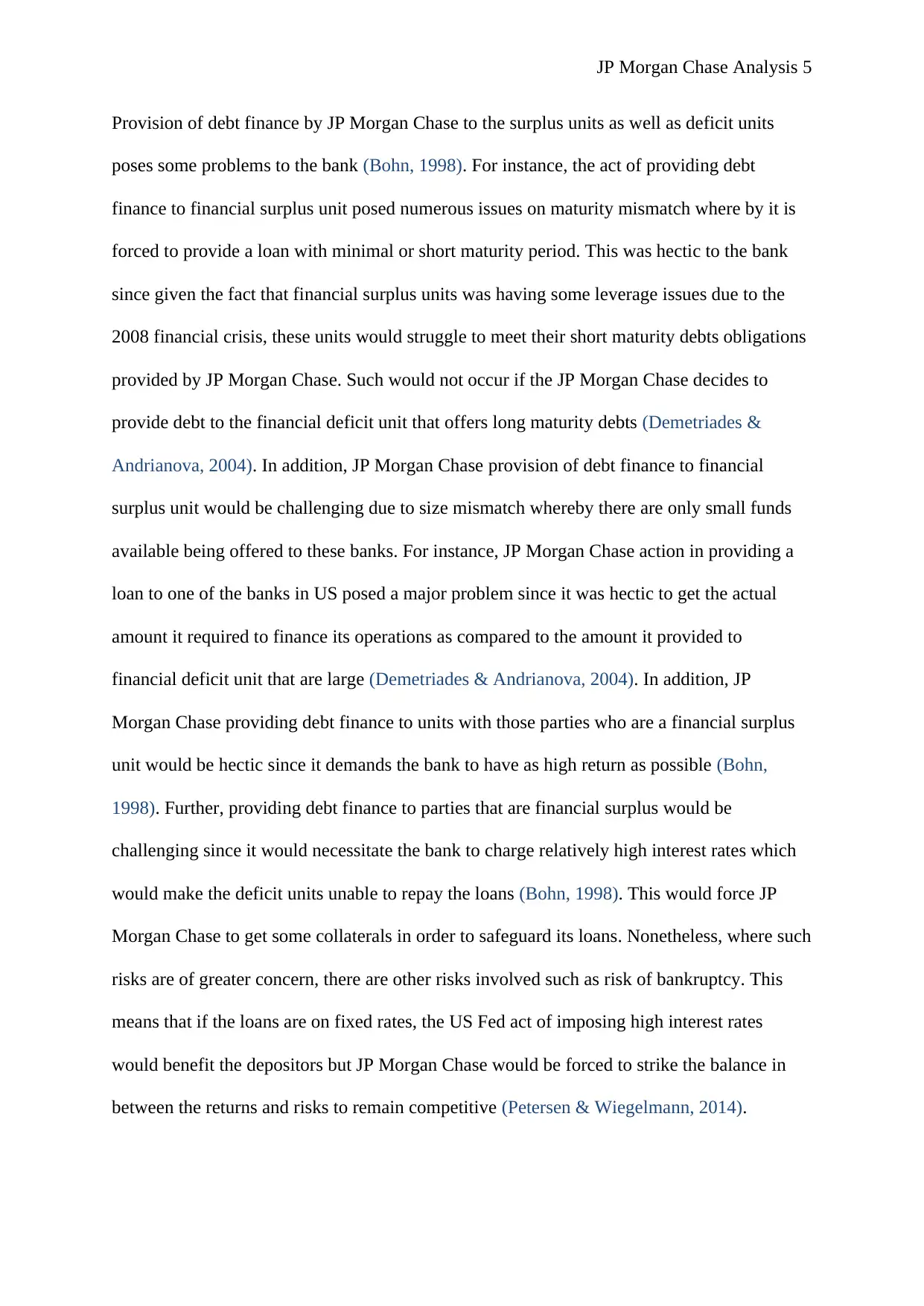
JP Morgan Chase Analysis 5
Provision of debt finance by JP Morgan Chase to the surplus units as well as deficit units
poses some problems to the bank (Bohn, 1998). For instance, the act of providing debt
finance to financial surplus unit posed numerous issues on maturity mismatch where by it is
forced to provide a loan with minimal or short maturity period. This was hectic to the bank
since given the fact that financial surplus units was having some leverage issues due to the
2008 financial crisis, these units would struggle to meet their short maturity debts obligations
provided by JP Morgan Chase. Such would not occur if the JP Morgan Chase decides to
provide debt to the financial deficit unit that offers long maturity debts (Demetriades &
Andrianova, 2004). In addition, JP Morgan Chase provision of debt finance to financial
surplus unit would be challenging due to size mismatch whereby there are only small funds
available being offered to these banks. For instance, JP Morgan Chase action in providing a
loan to one of the banks in US posed a major problem since it was hectic to get the actual
amount it required to finance its operations as compared to the amount it provided to
financial deficit unit that are large (Demetriades & Andrianova, 2004). In addition, JP
Morgan Chase providing debt finance to units with those parties who are a financial surplus
unit would be hectic since it demands the bank to have as high return as possible (Bohn,
1998). Further, providing debt finance to parties that are financial surplus would be
challenging since it would necessitate the bank to charge relatively high interest rates which
would make the deficit units unable to repay the loans (Bohn, 1998). This would force JP
Morgan Chase to get some collaterals in order to safeguard its loans. Nonetheless, where such
risks are of greater concern, there are other risks involved such as risk of bankruptcy. This
means that if the loans are on fixed rates, the US Fed act of imposing high interest rates
would benefit the depositors but JP Morgan Chase would be forced to strike the balance in
between the returns and risks to remain competitive (Petersen & Wiegelmann, 2014).
Provision of debt finance by JP Morgan Chase to the surplus units as well as deficit units
poses some problems to the bank (Bohn, 1998). For instance, the act of providing debt
finance to financial surplus unit posed numerous issues on maturity mismatch where by it is
forced to provide a loan with minimal or short maturity period. This was hectic to the bank
since given the fact that financial surplus units was having some leverage issues due to the
2008 financial crisis, these units would struggle to meet their short maturity debts obligations
provided by JP Morgan Chase. Such would not occur if the JP Morgan Chase decides to
provide debt to the financial deficit unit that offers long maturity debts (Demetriades &
Andrianova, 2004). In addition, JP Morgan Chase provision of debt finance to financial
surplus unit would be challenging due to size mismatch whereby there are only small funds
available being offered to these banks. For instance, JP Morgan Chase action in providing a
loan to one of the banks in US posed a major problem since it was hectic to get the actual
amount it required to finance its operations as compared to the amount it provided to
financial deficit unit that are large (Demetriades & Andrianova, 2004). In addition, JP
Morgan Chase providing debt finance to units with those parties who are a financial surplus
unit would be hectic since it demands the bank to have as high return as possible (Bohn,
1998). Further, providing debt finance to parties that are financial surplus would be
challenging since it would necessitate the bank to charge relatively high interest rates which
would make the deficit units unable to repay the loans (Bohn, 1998). This would force JP
Morgan Chase to get some collaterals in order to safeguard its loans. Nonetheless, where such
risks are of greater concern, there are other risks involved such as risk of bankruptcy. This
means that if the loans are on fixed rates, the US Fed act of imposing high interest rates
would benefit the depositors but JP Morgan Chase would be forced to strike the balance in
between the returns and risks to remain competitive (Petersen & Wiegelmann, 2014).

JP Morgan Chase Analysis 6
3. Main Changes to the Capital Adequacy, Liquidity and Leverage Requirements as
Stipulated by Basel III and Impact of such Changes on JP Morgan’s Financial
Conditions
Basel III is usually a sequence of measures designed in repairing and augmenting Basel II
accord (Ojo, 2013). This adjunct addresses the issues of the economic pro-cyclicality and
gives suggestions on the means of mitigating such issues through increase in capital charges
when country’s economies overheat as well as when capital charge reduces in the economic
contractions (Kasekende, Bagyenda & Brownbridge, 2011). Basically, the Basel III is far
much stricter and complete than the Basel II. Some of the reforms recommended in the Basel
III include the five facets for enhancing capital, raising quality, transparency and consistency
of capital base, enhancing risk-based capital needs with leverage ratio, enhancing risk
coverage, promoting country-cyclical buffers and reducing pro-cyclicality as well as
addressing interconnectedness and systematic risks (Ojo, 2013). The Basel III comprised of
some measures that are mainly targeted at improving the value and capacity of capital within
the economy, aimed at refining loss-absorption ability in both the liquidation and going
concerns setups. By retaining a minimum capital competence of 8%, Tier 1 was increased to
6% with equity postulated at 4.5% (Jayadev, 2013). These new concepts are for
countercyclical capital bumper and capital conversion bumper which ensured that financial
institutions are capable of absorbing the losses without any breach to the minimum capital
requirements and were capable of carrying their operations even during economic crisis
without deleveraging (Bhowmik, 2014).
Table 1: Regulatory Capital prescriptions under Basel III
3. Main Changes to the Capital Adequacy, Liquidity and Leverage Requirements as
Stipulated by Basel III and Impact of such Changes on JP Morgan’s Financial
Conditions
Basel III is usually a sequence of measures designed in repairing and augmenting Basel II
accord (Ojo, 2013). This adjunct addresses the issues of the economic pro-cyclicality and
gives suggestions on the means of mitigating such issues through increase in capital charges
when country’s economies overheat as well as when capital charge reduces in the economic
contractions (Kasekende, Bagyenda & Brownbridge, 2011). Basically, the Basel III is far
much stricter and complete than the Basel II. Some of the reforms recommended in the Basel
III include the five facets for enhancing capital, raising quality, transparency and consistency
of capital base, enhancing risk-based capital needs with leverage ratio, enhancing risk
coverage, promoting country-cyclical buffers and reducing pro-cyclicality as well as
addressing interconnectedness and systematic risks (Ojo, 2013). The Basel III comprised of
some measures that are mainly targeted at improving the value and capacity of capital within
the economy, aimed at refining loss-absorption ability in both the liquidation and going
concerns setups. By retaining a minimum capital competence of 8%, Tier 1 was increased to
6% with equity postulated at 4.5% (Jayadev, 2013). These new concepts are for
countercyclical capital bumper and capital conversion bumper which ensured that financial
institutions are capable of absorbing the losses without any breach to the minimum capital
requirements and were capable of carrying their operations even during economic crisis
without deleveraging (Bhowmik, 2014).
Table 1: Regulatory Capital prescriptions under Basel III
⊘ This is a preview!⊘
Do you want full access?
Subscribe today to unlock all pages.

Trusted by 1+ million students worldwide
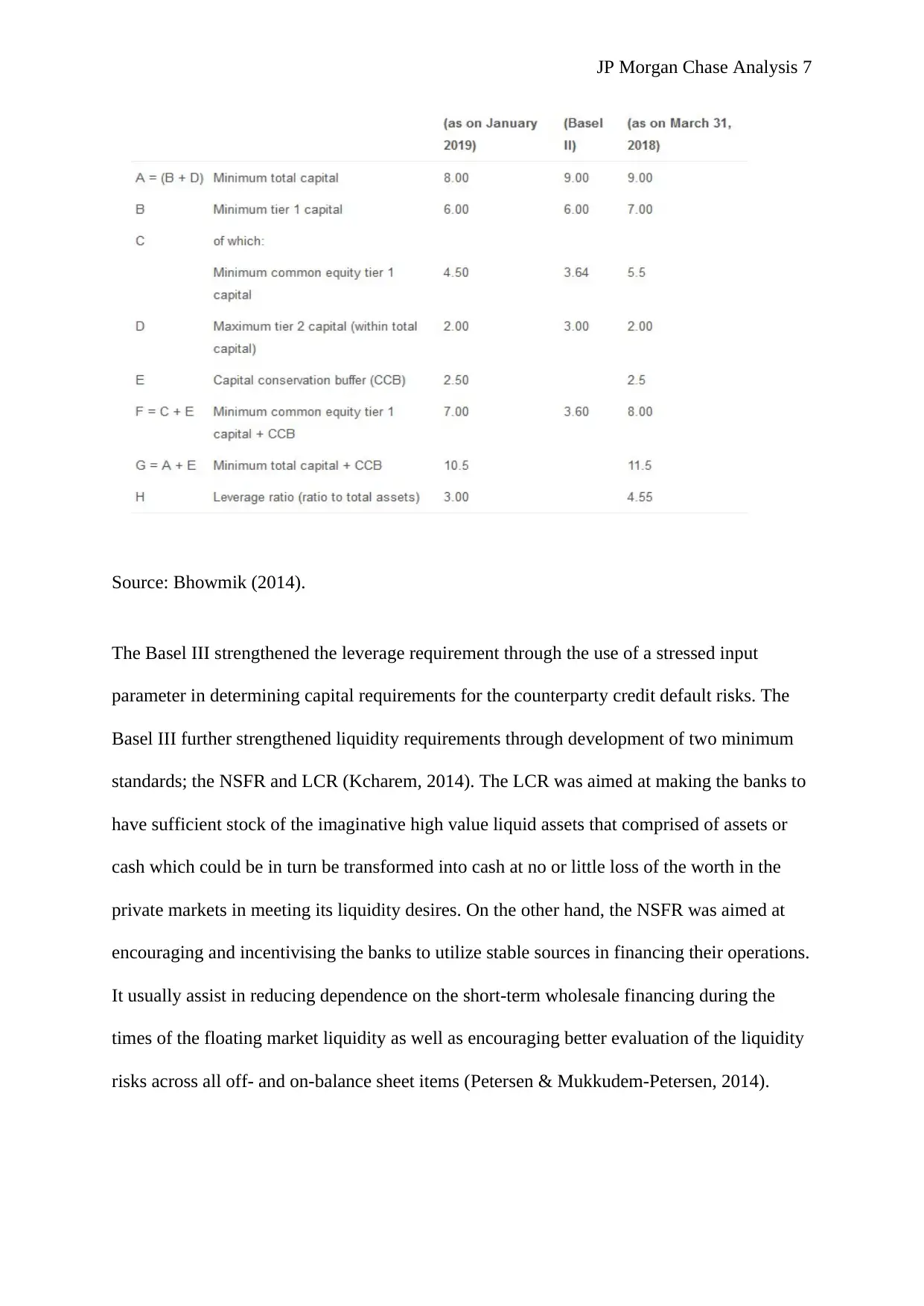
JP Morgan Chase Analysis 7
Source: Bhowmik (2014).
The Basel III strengthened the leverage requirement through the use of a stressed input
parameter in determining capital requirements for the counterparty credit default risks. The
Basel III further strengthened liquidity requirements through development of two minimum
standards; the NSFR and LCR (Kcharem, 2014). The LCR was aimed at making the banks to
have sufficient stock of the imaginative high value liquid assets that comprised of assets or
cash which could be in turn be transformed into cash at no or little loss of the worth in the
private markets in meeting its liquidity desires. On the other hand, the NSFR was aimed at
encouraging and incentivising the banks to utilize stable sources in financing their operations.
It usually assist in reducing dependence on the short-term wholesale financing during the
times of the floating market liquidity as well as encouraging better evaluation of the liquidity
risks across all off- and on-balance sheet items (Petersen & Mukkudem-Petersen, 2014).
Source: Bhowmik (2014).
The Basel III strengthened the leverage requirement through the use of a stressed input
parameter in determining capital requirements for the counterparty credit default risks. The
Basel III further strengthened liquidity requirements through development of two minimum
standards; the NSFR and LCR (Kcharem, 2014). The LCR was aimed at making the banks to
have sufficient stock of the imaginative high value liquid assets that comprised of assets or
cash which could be in turn be transformed into cash at no or little loss of the worth in the
private markets in meeting its liquidity desires. On the other hand, the NSFR was aimed at
encouraging and incentivising the banks to utilize stable sources in financing their operations.
It usually assist in reducing dependence on the short-term wholesale financing during the
times of the floating market liquidity as well as encouraging better evaluation of the liquidity
risks across all off- and on-balance sheet items (Petersen & Mukkudem-Petersen, 2014).
Paraphrase This Document
Need a fresh take? Get an instant paraphrase of this document with our AI Paraphraser
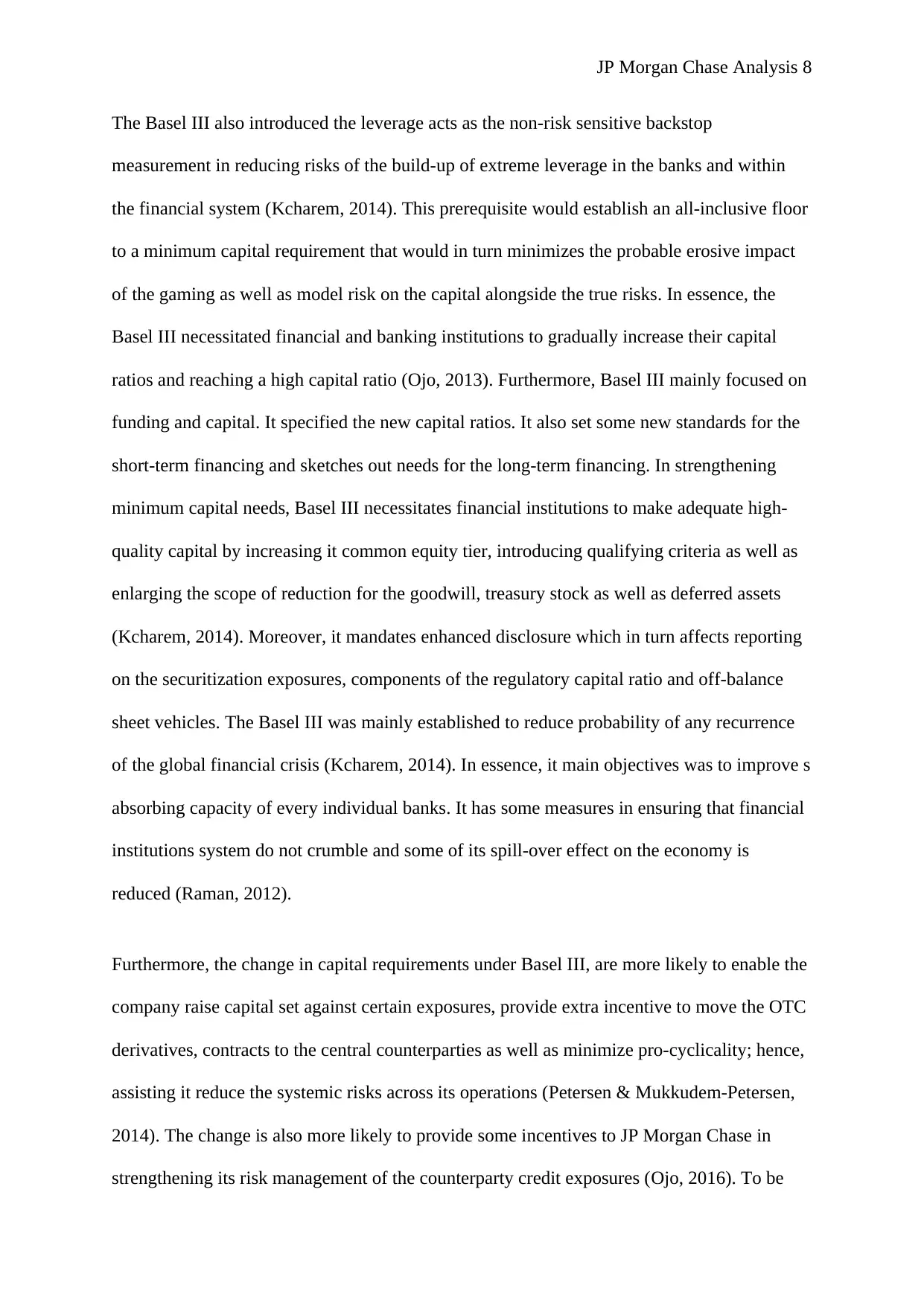
JP Morgan Chase Analysis 8
The Basel III also introduced the leverage acts as the non-risk sensitive backstop
measurement in reducing risks of the build-up of extreme leverage in the banks and within
the financial system (Kcharem, 2014). This prerequisite would establish an all-inclusive floor
to a minimum capital requirement that would in turn minimizes the probable erosive impact
of the gaming as well as model risk on the capital alongside the true risks. In essence, the
Basel III necessitated financial and banking institutions to gradually increase their capital
ratios and reaching a high capital ratio (Ojo, 2013). Furthermore, Basel III mainly focused on
funding and capital. It specified the new capital ratios. It also set some new standards for the
short-term financing and sketches out needs for the long-term financing. In strengthening
minimum capital needs, Basel III necessitates financial institutions to make adequate high-
quality capital by increasing it common equity tier, introducing qualifying criteria as well as
enlarging the scope of reduction for the goodwill, treasury stock as well as deferred assets
(Kcharem, 2014). Moreover, it mandates enhanced disclosure which in turn affects reporting
on the securitization exposures, components of the regulatory capital ratio and off-balance
sheet vehicles. The Basel III was mainly established to reduce probability of any recurrence
of the global financial crisis (Kcharem, 2014). In essence, it main objectives was to improve s
absorbing capacity of every individual banks. It has some measures in ensuring that financial
institutions system do not crumble and some of its spill-over effect on the economy is
reduced (Raman, 2012).
Furthermore, the change in capital requirements under Basel III, are more likely to enable the
company raise capital set against certain exposures, provide extra incentive to move the OTC
derivatives, contracts to the central counterparties as well as minimize pro-cyclicality; hence,
assisting it reduce the systemic risks across its operations (Petersen & Mukkudem-Petersen,
2014). The change is also more likely to provide some incentives to JP Morgan Chase in
strengthening its risk management of the counterparty credit exposures (Ojo, 2016). To be
The Basel III also introduced the leverage acts as the non-risk sensitive backstop
measurement in reducing risks of the build-up of extreme leverage in the banks and within
the financial system (Kcharem, 2014). This prerequisite would establish an all-inclusive floor
to a minimum capital requirement that would in turn minimizes the probable erosive impact
of the gaming as well as model risk on the capital alongside the true risks. In essence, the
Basel III necessitated financial and banking institutions to gradually increase their capital
ratios and reaching a high capital ratio (Ojo, 2013). Furthermore, Basel III mainly focused on
funding and capital. It specified the new capital ratios. It also set some new standards for the
short-term financing and sketches out needs for the long-term financing. In strengthening
minimum capital needs, Basel III necessitates financial institutions to make adequate high-
quality capital by increasing it common equity tier, introducing qualifying criteria as well as
enlarging the scope of reduction for the goodwill, treasury stock as well as deferred assets
(Kcharem, 2014). Moreover, it mandates enhanced disclosure which in turn affects reporting
on the securitization exposures, components of the regulatory capital ratio and off-balance
sheet vehicles. The Basel III was mainly established to reduce probability of any recurrence
of the global financial crisis (Kcharem, 2014). In essence, it main objectives was to improve s
absorbing capacity of every individual banks. It has some measures in ensuring that financial
institutions system do not crumble and some of its spill-over effect on the economy is
reduced (Raman, 2012).
Furthermore, the change in capital requirements under Basel III, are more likely to enable the
company raise capital set against certain exposures, provide extra incentive to move the OTC
derivatives, contracts to the central counterparties as well as minimize pro-cyclicality; hence,
assisting it reduce the systemic risks across its operations (Petersen & Mukkudem-Petersen,
2014). The change is also more likely to provide some incentives to JP Morgan Chase in
strengthening its risk management of the counterparty credit exposures (Ojo, 2016). To be

JP Morgan Chase Analysis 9
more specific, the change in capital requirements under the Basel III would expose the bank
books to attract some enhanced capital charges. Therefore, JP Morgan Chase would have
common equity capital under the Basel III which would stand it in good stead (Raman, 2012).
Basel III also introduced new liquidity policies aimed at improving resilience of the financial
and banking institutions to liquidity shocks (Ojo, 2013). This necessitated financial
institutions to maintain buffer of extremely liquid securities commonly measured by liquidity
coverage ratio. The buffer is usually aimed at promoting resilience to probable liquidity
disruptions over the month (Petersen & Mukkudem-Petersen, 2014). These standards are
likely to affect JP Morgan Chase financial conditions by ensuring that this bank has adequate
unencumbered, as well as high-liquid assets in offsetting its net cash outflows encountered
under its acute short-term operations. In addition, the new liquidity standards is more likely to
cause a significant downgrade in JP Morgan Chase’s public credit rating, a loss of the
unsecured wholesale financing, increase in derivative substantial and collateral calls on the
non-contractual as well as contractual off-balance sheet revelations, partial loss of deposits as
well as increase in the secured funding haircuts (Raman, 2012).
Another liquidity measure under the Basel III is the net stable financing ratio (Ojo, 2016).
This standard necessitates minimum value of the stable bases of financing at the institutions
in relation to liquidity profile of assets and potential for the provisional liquidity requirements
emerging from the off-balance sheet pledges, over the period. This standard would assist JP
Morgan Chase to border its over-dependence on temporary financing throughout times of the
floating arcade liquidity and would also hearten it to better evaluate its liquidity risk
diagonally through all the off- and on-balance sheet objects (Kcharem, 2014). Such measures
would promote resilience of the bank over the long-term by creating extra incentives for JP
more specific, the change in capital requirements under the Basel III would expose the bank
books to attract some enhanced capital charges. Therefore, JP Morgan Chase would have
common equity capital under the Basel III which would stand it in good stead (Raman, 2012).
Basel III also introduced new liquidity policies aimed at improving resilience of the financial
and banking institutions to liquidity shocks (Ojo, 2013). This necessitated financial
institutions to maintain buffer of extremely liquid securities commonly measured by liquidity
coverage ratio. The buffer is usually aimed at promoting resilience to probable liquidity
disruptions over the month (Petersen & Mukkudem-Petersen, 2014). These standards are
likely to affect JP Morgan Chase financial conditions by ensuring that this bank has adequate
unencumbered, as well as high-liquid assets in offsetting its net cash outflows encountered
under its acute short-term operations. In addition, the new liquidity standards is more likely to
cause a significant downgrade in JP Morgan Chase’s public credit rating, a loss of the
unsecured wholesale financing, increase in derivative substantial and collateral calls on the
non-contractual as well as contractual off-balance sheet revelations, partial loss of deposits as
well as increase in the secured funding haircuts (Raman, 2012).
Another liquidity measure under the Basel III is the net stable financing ratio (Ojo, 2016).
This standard necessitates minimum value of the stable bases of financing at the institutions
in relation to liquidity profile of assets and potential for the provisional liquidity requirements
emerging from the off-balance sheet pledges, over the period. This standard would assist JP
Morgan Chase to border its over-dependence on temporary financing throughout times of the
floating arcade liquidity and would also hearten it to better evaluate its liquidity risk
diagonally through all the off- and on-balance sheet objects (Kcharem, 2014). Such measures
would promote resilience of the bank over the long-term by creating extra incentives for JP
⊘ This is a preview!⊘
Do you want full access?
Subscribe today to unlock all pages.

Trusted by 1+ million students worldwide
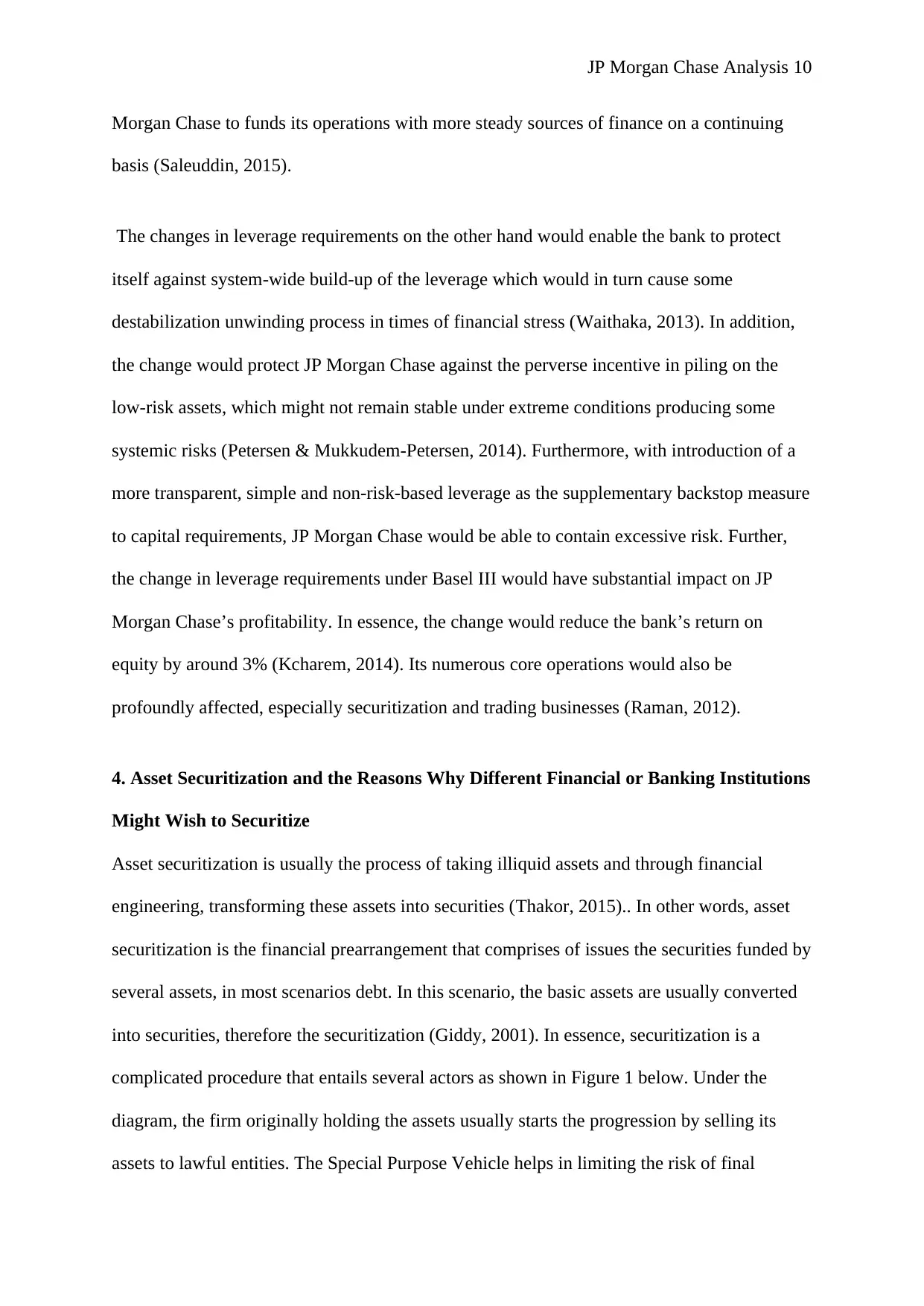
JP Morgan Chase Analysis 10
Morgan Chase to funds its operations with more steady sources of finance on a continuing
basis (Saleuddin, 2015).
The changes in leverage requirements on the other hand would enable the bank to protect
itself against system-wide build-up of the leverage which would in turn cause some
destabilization unwinding process in times of financial stress (Waithaka, 2013). In addition,
the change would protect JP Morgan Chase against the perverse incentive in piling on the
low-risk assets, which might not remain stable under extreme conditions producing some
systemic risks (Petersen & Mukkudem-Petersen, 2014). Furthermore, with introduction of a
more transparent, simple and non-risk-based leverage as the supplementary backstop measure
to capital requirements, JP Morgan Chase would be able to contain excessive risk. Further,
the change in leverage requirements under Basel III would have substantial impact on JP
Morgan Chase’s profitability. In essence, the change would reduce the bank’s return on
equity by around 3% (Kcharem, 2014). Its numerous core operations would also be
profoundly affected, especially securitization and trading businesses (Raman, 2012).
4. Asset Securitization and the Reasons Why Different Financial or Banking Institutions
Might Wish to Securitize
Asset securitization is usually the process of taking illiquid assets and through financial
engineering, transforming these assets into securities (Thakor, 2015).. In other words, asset
securitization is the financial prearrangement that comprises of issues the securities funded by
several assets, in most scenarios debt. In this scenario, the basic assets are usually converted
into securities, therefore the securitization (Giddy, 2001). In essence, securitization is a
complicated procedure that entails several actors as shown in Figure 1 below. Under the
diagram, the firm originally holding the assets usually starts the progression by selling its
assets to lawful entities. The Special Purpose Vehicle helps in limiting the risk of final
Morgan Chase to funds its operations with more steady sources of finance on a continuing
basis (Saleuddin, 2015).
The changes in leverage requirements on the other hand would enable the bank to protect
itself against system-wide build-up of the leverage which would in turn cause some
destabilization unwinding process in times of financial stress (Waithaka, 2013). In addition,
the change would protect JP Morgan Chase against the perverse incentive in piling on the
low-risk assets, which might not remain stable under extreme conditions producing some
systemic risks (Petersen & Mukkudem-Petersen, 2014). Furthermore, with introduction of a
more transparent, simple and non-risk-based leverage as the supplementary backstop measure
to capital requirements, JP Morgan Chase would be able to contain excessive risk. Further,
the change in leverage requirements under Basel III would have substantial impact on JP
Morgan Chase’s profitability. In essence, the change would reduce the bank’s return on
equity by around 3% (Kcharem, 2014). Its numerous core operations would also be
profoundly affected, especially securitization and trading businesses (Raman, 2012).
4. Asset Securitization and the Reasons Why Different Financial or Banking Institutions
Might Wish to Securitize
Asset securitization is usually the process of taking illiquid assets and through financial
engineering, transforming these assets into securities (Thakor, 2015).. In other words, asset
securitization is the financial prearrangement that comprises of issues the securities funded by
several assets, in most scenarios debt. In this scenario, the basic assets are usually converted
into securities, therefore the securitization (Giddy, 2001). In essence, securitization is a
complicated procedure that entails several actors as shown in Figure 1 below. Under the
diagram, the firm originally holding the assets usually starts the progression by selling its
assets to lawful entities. The Special Purpose Vehicle helps in limiting the risk of final
Paraphrase This Document
Need a fresh take? Get an instant paraphrase of this document with our AI Paraphraser
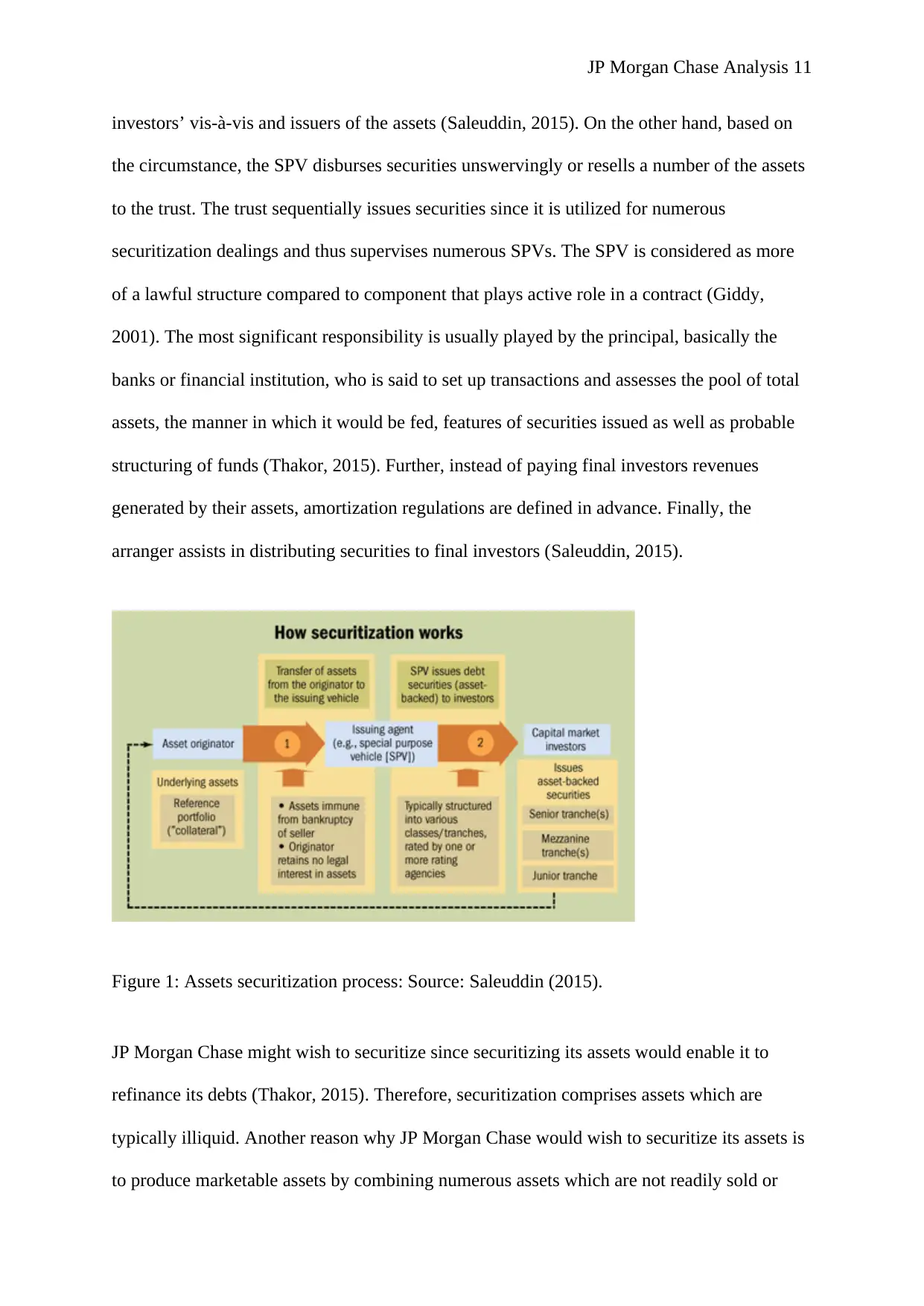
JP Morgan Chase Analysis 11
investors’ vis-à-vis and issuers of the assets (Saleuddin, 2015). On the other hand, based on
the circumstance, the SPV disburses securities unswervingly or resells a number of the assets
to the trust. The trust sequentially issues securities since it is utilized for numerous
securitization dealings and thus supervises numerous SPVs. The SPV is considered as more
of a lawful structure compared to component that plays active role in a contract (Giddy,
2001). The most significant responsibility is usually played by the principal, basically the
banks or financial institution, who is said to set up transactions and assesses the pool of total
assets, the manner in which it would be fed, features of securities issued as well as probable
structuring of funds (Thakor, 2015). Further, instead of paying final investors revenues
generated by their assets, amortization regulations are defined in advance. Finally, the
arranger assists in distributing securities to final investors (Saleuddin, 2015).
Figure 1: Assets securitization process: Source: Saleuddin (2015).
JP Morgan Chase might wish to securitize since securitizing its assets would enable it to
refinance its debts (Thakor, 2015). Therefore, securitization comprises assets which are
typically illiquid. Another reason why JP Morgan Chase would wish to securitize its assets is
to produce marketable assets by combining numerous assets which are not readily sold or
investors’ vis-à-vis and issuers of the assets (Saleuddin, 2015). On the other hand, based on
the circumstance, the SPV disburses securities unswervingly or resells a number of the assets
to the trust. The trust sequentially issues securities since it is utilized for numerous
securitization dealings and thus supervises numerous SPVs. The SPV is considered as more
of a lawful structure compared to component that plays active role in a contract (Giddy,
2001). The most significant responsibility is usually played by the principal, basically the
banks or financial institution, who is said to set up transactions and assesses the pool of total
assets, the manner in which it would be fed, features of securities issued as well as probable
structuring of funds (Thakor, 2015). Further, instead of paying final investors revenues
generated by their assets, amortization regulations are defined in advance. Finally, the
arranger assists in distributing securities to final investors (Saleuddin, 2015).
Figure 1: Assets securitization process: Source: Saleuddin (2015).
JP Morgan Chase might wish to securitize since securitizing its assets would enable it to
refinance its debts (Thakor, 2015). Therefore, securitization comprises assets which are
typically illiquid. Another reason why JP Morgan Chase would wish to securitize its assets is
to produce marketable assets by combining numerous assets which are not readily sold or
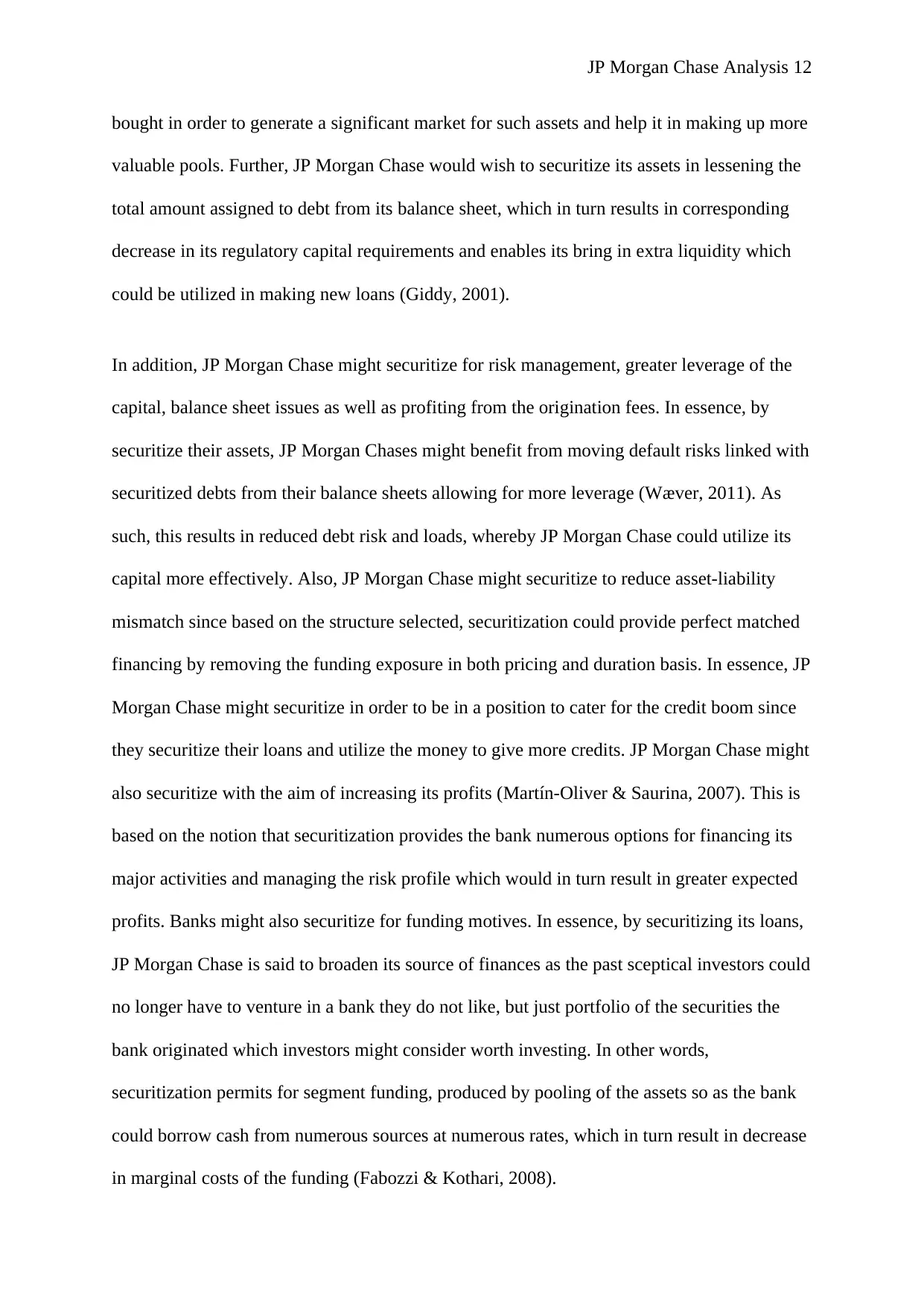
JP Morgan Chase Analysis 12
bought in order to generate a significant market for such assets and help it in making up more
valuable pools. Further, JP Morgan Chase would wish to securitize its assets in lessening the
total amount assigned to debt from its balance sheet, which in turn results in corresponding
decrease in its regulatory capital requirements and enables its bring in extra liquidity which
could be utilized in making new loans (Giddy, 2001).
In addition, JP Morgan Chase might securitize for risk management, greater leverage of the
capital, balance sheet issues as well as profiting from the origination fees. In essence, by
securitize their assets, JP Morgan Chases might benefit from moving default risks linked with
securitized debts from their balance sheets allowing for more leverage (Wæver, 2011). As
such, this results in reduced debt risk and loads, whereby JP Morgan Chase could utilize its
capital more effectively. Also, JP Morgan Chase might securitize to reduce asset-liability
mismatch since based on the structure selected, securitization could provide perfect matched
financing by removing the funding exposure in both pricing and duration basis. In essence, JP
Morgan Chase might securitize in order to be in a position to cater for the credit boom since
they securitize their loans and utilize the money to give more credits. JP Morgan Chase might
also securitize with the aim of increasing its profits (Martín-Oliver & Saurina, 2007). This is
based on the notion that securitization provides the bank numerous options for financing its
major activities and managing the risk profile which would in turn result in greater expected
profits. Banks might also securitize for funding motives. In essence, by securitizing its loans,
JP Morgan Chase is said to broaden its source of finances as the past sceptical investors could
no longer have to venture in a bank they do not like, but just portfolio of the securities the
bank originated which investors might consider worth investing. In other words,
securitization permits for segment funding, produced by pooling of the assets so as the bank
could borrow cash from numerous sources at numerous rates, which in turn result in decrease
in marginal costs of the funding (Fabozzi & Kothari, 2008).
bought in order to generate a significant market for such assets and help it in making up more
valuable pools. Further, JP Morgan Chase would wish to securitize its assets in lessening the
total amount assigned to debt from its balance sheet, which in turn results in corresponding
decrease in its regulatory capital requirements and enables its bring in extra liquidity which
could be utilized in making new loans (Giddy, 2001).
In addition, JP Morgan Chase might securitize for risk management, greater leverage of the
capital, balance sheet issues as well as profiting from the origination fees. In essence, by
securitize their assets, JP Morgan Chases might benefit from moving default risks linked with
securitized debts from their balance sheets allowing for more leverage (Wæver, 2011). As
such, this results in reduced debt risk and loads, whereby JP Morgan Chase could utilize its
capital more effectively. Also, JP Morgan Chase might securitize to reduce asset-liability
mismatch since based on the structure selected, securitization could provide perfect matched
financing by removing the funding exposure in both pricing and duration basis. In essence, JP
Morgan Chase might securitize in order to be in a position to cater for the credit boom since
they securitize their loans and utilize the money to give more credits. JP Morgan Chase might
also securitize with the aim of increasing its profits (Martín-Oliver & Saurina, 2007). This is
based on the notion that securitization provides the bank numerous options for financing its
major activities and managing the risk profile which would in turn result in greater expected
profits. Banks might also securitize for funding motives. In essence, by securitizing its loans,
JP Morgan Chase is said to broaden its source of finances as the past sceptical investors could
no longer have to venture in a bank they do not like, but just portfolio of the securities the
bank originated which investors might consider worth investing. In other words,
securitization permits for segment funding, produced by pooling of the assets so as the bank
could borrow cash from numerous sources at numerous rates, which in turn result in decrease
in marginal costs of the funding (Fabozzi & Kothari, 2008).
⊘ This is a preview!⊘
Do you want full access?
Subscribe today to unlock all pages.

Trusted by 1+ million students worldwide
1 out of 21
Related Documents
Your All-in-One AI-Powered Toolkit for Academic Success.
+13062052269
info@desklib.com
Available 24*7 on WhatsApp / Email
![[object Object]](/_next/static/media/star-bottom.7253800d.svg)
Unlock your academic potential
Copyright © 2020–2025 A2Z Services. All Rights Reserved. Developed and managed by ZUCOL.




